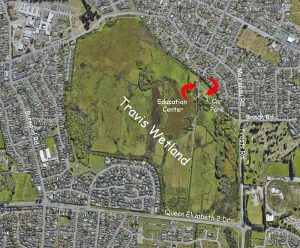 |
September 2018
Workday reminder, September 15 2018
Travis workday, Saturday September 15 2018, 9:30 am – 12:30.
Meet at the education centre (the old farm
house) behind the Beach Rd car park at 9.30 am. Note the later start time because this month is the annual Trees for Canterbury planting day.
This year is a milestone in Trees for Canterbury history, the one-millionth tree that they have donated to the community will be planted at Travis.
We will be planting down the Matai / Totara forest and then coming up to the plantings behind the carpark area for the ceremonial planting at 12 mid day.
Please wear appropriate clothing and footwear, Travis is wet at present.
All gear provided.
There will be a Bar-B-Que afterwards.
Latest News
Workday Saturday 18 August
Following a very rainy night it was a little hard to get up early for a workday. However, hardy souls were rewarded on arrival by the antics of a pair of black swans and three cygnets on the Beach Road driveway. Less pleasing were the capers of a couple of black cats as we walked around to Mairehau dunes.
Once there we continued with the enrichment planting commenced in July. It was chilly at the start with a little drizzle, but there is nothing like physical work for generating heat.
About 15 people helped out and it was very pleasing to meet 4 new volunteers. We hope they will come along again. We missed John, our ranger, who is recuperating after a shoulder operation, but were pleased to have Colin Meurk there to ensure plants were placed in optimal positions. We planted over 100 plants and many were larger specimens requiring bigger holes to be dug. Species included ake ake, broadleaf, manuka, sand coprosma and porcupine plant.
It was noted that Council contractors had been mowing quite a wide strip along the edge of the path, so we were careful to keep our new plants well back.
Established plants at the site seemed to be doing well and those planted in July looked healthy. The hebes looked particularly lush and their flowers will soon be providing nectar for copper and admiral butterflies. The red admiral butterfly (kahukura) is found only in New Zealand and can live for 6 to 9 months, including the winter period. Nectar from flowers such as hebe and lacebark are very important for survival, as are nettles for larval food. Copper butterflies are also interesting and New Zealand has a large number of species compared with other countries – 22 types are found in the South Island. Luckily we have planted some Muehlenbeckia sp. which are important food plants for copper caterpillars.
Planting was completed in good time and new plants were watered were possible. The sandy soil was very dry deeper down despite the recent rain.
Thanks to all who participated.
Article: Sue Britain, Image: Dave Evans
Trees For Canterbury
Each year for at least 15 years, and probably much longer, Trees for Canterbury have been donating hundreds and more recently thousands of plants towards the restoration of Travis Wetland. The Trees for Canterbury annual public planting day in September has become the highlight of our monthly workdays and a welcome celebration of the start of Spring. The number of people Trees for Canterbury attract to this event increases each year and cooking enough sausages to feed the hungry workers becomes more challenging each time.
Trees for Canterbury has been operational for 28 years and you can read about their inspiring story here.
Each year they produce 100,000 plants and on average 45,000 of these are donated to the community. A truly awesome achievement for a flax-roots enterprise.
The September planting this year will be a special one, as Trees for Canterbury will be celebrating their millionth donated native plant at Travis Wetland. That is a great honour for the wetland and serves to underline the many thousands of plants Trees for Canterbury has donated to the wetland. The planting will start at 10am on the 15th of September and at noon a ceremonial planting will mark the occasion. The ceremony will be followed by the traditional BBQ at the Education Centre, please join us to mark the occasion.
Article: Dave Evans
Green Mistletoe, Ileostylus micranthus, Pirita
In 2017 the Christchurch City Council started the Backyard Mistletoe project. The purpose of this project was to get Christchurch citizens to spread the native green mistletoe/pirita around the city by putting it in their own back gardens and in reserves.
Native birds are the main spreaders of the mistletoe’s seed; they eat the berries and then wipe their bills on a tree branch to remove the sticky seed. The seed gets lodged in a crack on the bark and then germinates. However, Christchurch does not have a large native bird population that can distribute the seed and the mistletoe is rare in the city.
In 2017, over 300 people took advantage of the opportunity to sow mistletoe seeds. Each person was given five seeds and instructions on how to distribute them. From surveying these volunteers the City Council know that at least 350 mistletoe have germinated.
The Travis Wetland Trust went along and got a pack of seeds to put out at the wetland. Some were put on trees in the carpark and others along the track to the bird hide. We waited with trepidation to see if they would germinate. A year went by and the Council started promoting the 2018 Backyard Mistletoe project. Feeling a little deflated that our mistletoe had not struck from 2017 I went out and checked again. Much to my pleasure and surprise one of our seeds had germinated! We now wait to see if the plant will establish and one day hope to see pirita wide spread in the wetland and the wider city.
If you want to know more about New Zealand’s mistletoe check out DOCS factsheet https://www.doc.govt.nz/Documents/about-doc/concessions-and-permits/conservation-revealed/nz-mistletoes-lowres.pdf
Article: Denise Ford
Latest Images









